
Dusting Off Profits
March 26, 2013
By Myriam Gauthier
If timing is everything, then launching a pellet complex at the height of the forestry crisis may have been a mistake.
If timing is everything, then launching a pellet complex at the height of the forestry crisis may have been a mistake. Yet four years later, lumber manufacturer Boisaco’s pellet plant continues operations.
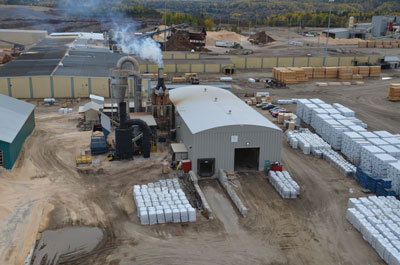
|
|
| The Granulco pellet plant was added to the Boisaco industrial site in December 2009 to provide an outlet for the mill’s sawdust and employment for 13. Photos: Granulco
|
Since 2009, this sawmill in Sacré-Coeur, Quebec, in the North Shore region, has run its Granulco pellet division (granules is the French word for pellet). Faced with record low lumber pricing, the company has gone through tough times, but its leaders have never ceased to believe that the full use of byproducts from wood remains a promising market.
“Not so long ago, 10 to 15 years, sawdust from mills around here was buried as waste,” says Boisaco president Steeve St-Gelais. “Now, it is a commodity that can create jobs and a profitable business. “
Some of the mill shavings and chips were already used by sister companies Ripco and Sacopan, for the manufacture of equestrian bedding and embossed door panels. These remanufacturers were launched on the Boisaco industrial site in the early 2000s as an indication of the company’s intention of making full use of its fibre resource to maximize revenue and employment. The company has annual revenues of more than $60 million.
It was that spirit that saw Granulco added to the complex in December 2009, providing a local outlet for sawdust from the 110-million-board-foot sawmill. Granulco has an annual production capacity of 20,000 to 40,000 tonnes aimed at the domestic and commercial pellet stove market as well as equestrian bedding.
According to Granulco president Bastien Deschênes, producing value-added products is now a matter of survival for Quebec’s forest sector: “It is no longer a choice, it is an obligation,” he says. “The forestry crisis has been very difficult for the North Shore region: only four of the original 12 lumber producers have survived. I am convinced that Boisaco would not have passed through the crisis if it had not already diversified its operations.”
Co-operative Values
Granulco was formed by six original investors: The Essipit Innu First Nation, the Sacré-Coeur investment company Investra, the Sacre-Coeur Economic Development Corporation, Boisaco, the Sacre Coeur Workers Cooperative (Unisaco), and the Sainte-Marguerite Forestry Workers Cooperative (Cofor).
Unisaco and Cofor are majority co-operative shareholders of Boisaco itself, a co-operative that includes the mill staff. “The mill is not a co-operative, but is managed under a co-operative model,” St-Gelais explains. “In fact the workers formed the two co-operatives in 1985, which in turn revived the sawmill after it experienced three successive bankruptcies. That is how Boisaco was formed.”
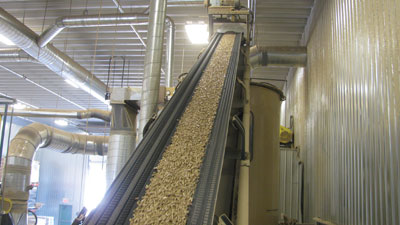 |
|
| The pellets are made from almost 100% softwood sawdust (black spruce, fir, pine). |
|
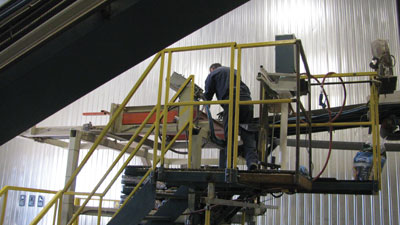 |
|
| Granulco currently targets the domestic heat market | |
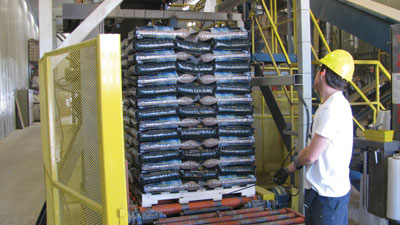 |
|
| Bagging about one million 40-pound bags annually. |
Co-operative values also guided Granulco management during the construction of the pellet plant, says Deschênes. “We have the means to invest in mechanization, but because of our model, we prefer to encourage job creation through investment,” the seasoned businessman explains. “Our goal is to contribute to the economy of the region, not to enrich a single shareholder.”
Granulco hired 13 full-time staff to start, and could hire more if pellet demand increases. For now, Granulco annually produces 20,000 tonnes of pellets, its minimum production capacity.
Construction of the 8,000-square-foot plant occurred over a period of a few months. The principal equipment and technolgy suppliers were Gaston Richard (milling and pellet production equipment), RX Industries (dust control), Honco (building) and FABMEC (production equipment).
The team also visited other pellet plants before the work began. “You could say our expertise in this area is recent,” quips Deschênes. “We visited biomass plants in the Prairies and elsewhere to get an idea of how to proceed.”
Raw fibre is supplied by the adjacent sawmill, and fed through a Double Diamond Farms 12×40-foot triple-pass rotary dryer rebuilt by the mill’s maintenance staff. Fibre is then processed in a Bliss E-44095-TF dry hammermill ahead of two pellet lines. The mill runs a Bliss B200B-120 as well as an Andritz 125-horsepower mill. Pellets are cooled via a Bliss 8-130-6A tower ahead of a Taylor bagging system and Polyroboteck stacker.
Once the equipment was installed, ramp-up took a few months, and changes were made throughout the process. Particular attention was also paid to health and safety given the reputation of pellet plants when it comes to fire.
“The accumulation of dry wood dust can turn the plant into a tinderbox,” Deschênes notes. The presence of sawdust in the air can cause an explosion at the slightest spark. “It is for this reason, among others, the rotary sawdust dryer among other equipment is outside. We also have an array of spark and fire protection equipment.”
In fact, the design includes a full spark detection and suppression system from Hansentek.
Challenge
In 2008, the demand for pellets grew in Quebec, before falling in 2009 during the depth of the forestry crisis and under the effects of the general global economic recession.
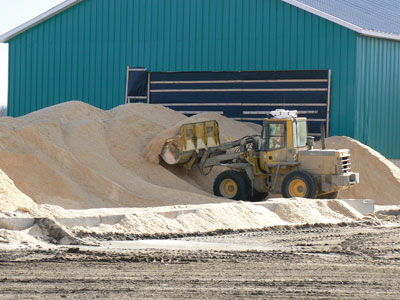 |
|
| The plant uses 5% sawdust from yellow and white birch provided by Bersaco, a nearby sawmill and pallet components factory. Photos: Myriam Gauthier
|
“2008 was the frenzy before the crisis, and then we had to go through a series of cycles in difficult markets,” Deschênes recalls. “Before the crisis, the price of a 40-pound bag of pellets approached $5. Now, with a gradual recovery, the bags sell in the $4 range.”
The drop in demand led to a temporary suspension of operations for a few months during the winter of 2011. Some employees were transferred to Boisaco during this period. Yet Granulco survived. “There is no doubt these rough markets have delayed our plans. In many ways we are lucky, as we have some clear synergies between the sites, such as the electricity and water infrastructure, for example, “says Deschênes.
Market Eco-energy
Granulco is for the moment chiefly in the domestic heat market: the factory produces annually about one million bags of pellets for stoves. The pellets are made from softwood sawdust (black spruce, fir, pine) from the Boisaco sawmill. The plant also uses at times 5% of white and yellow birch sawdust provided by Bersaco, a sawmill and pallet component supplier on another Boisaco industrial site in the municipality of Grandes-Bergeronnes.
Aspen sawdust also from Bersaco is set aside, and since 2012 is used as fuel for the plant’s boiler. “The compression of aspen sawdust is more difficult, since there is not much lignin in this species, so we decided to use it otherwise to avoid waste,” says Deschênes.
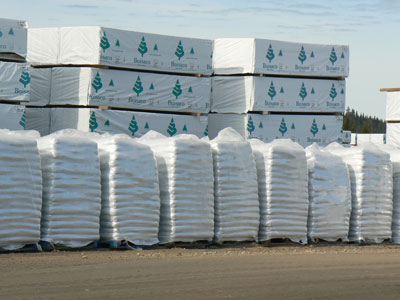
|
|
| Wood pallets with bags of Granulco pellets. The pellet industry has considerable market development work to do in hydro-rich Quebec. |
|
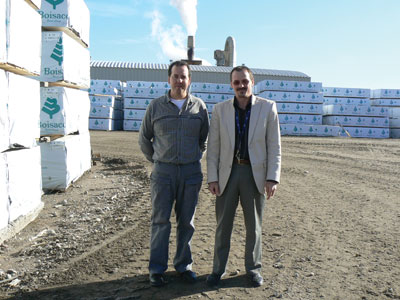 |
|
| Bastien Deschênes (left), president of Granulco, and Steeve St-Gelais, president of Boisaco, say co-operative values guided construction of the pellet plant. | |
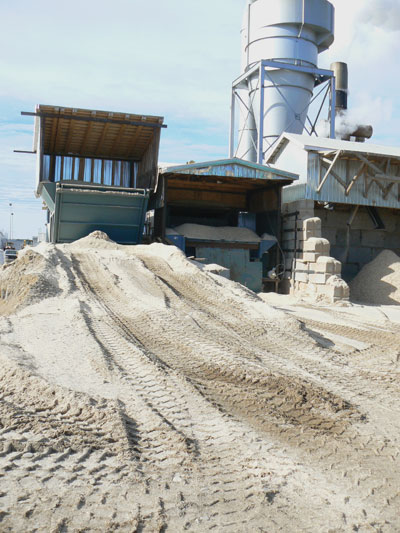 |
|
| Aspen sawdust from Bersaco does not bind well, and so it is used as fuel for the burner. |
Competing with Quebec’s famously low hydro prices is not easy. Granulco markets to a clientele attracted by the social and environmental benefits of using a local, low-carbon forest waste product, as well as those seeking the ambience created by a wood stove. The financial argument is also put forward where it makes sense, says sales manager Jean-François Bouchard.
“Biomass heating is a much cheaper alternative than heating oil,” he notes. “On this point, Europe is 20 years ahead of Quebec. Trucks go from house to house to fill pellet tanks. We are far from reaching that point here, because of the low price of electricity in Quebec, because the product has yet to be known.”
That may slowly be changing, as various high-profile pellet heat projects involving apartment blocks in Quebec City and ski chalets at Le Massif begin to garner press.
According to data provided by the Director General of Forest Energy of the Quebec Federation of Forestry Cooperatives, Eugene Gagné, pellet heating costs $0.0675/ kWh, taking into account the current price of bags on the market at the end of January 2013. Heating with pellets is about 50% cheaper than oil heating ($0.1286/kWh), and in the same ball park as heating with electricity ($0.0751/kWh).
The bagged heating product, which represents approximately 90% of the plant’s production, is distributed throughout Quebec in some retail stores. Currently, Granulco is not exporting to the U.S. market.
The company also says exports to Europe may be in its future. “In Quebec, there is a need for pellets for heating in winter, but in summer, when the plant continues to operate, we may export to France, Belgium and Italy, for example, as a good means to sell our stocks,” says Jean-François Bouchard.
The plant also produces equestrian bedding sold in bags of 40 pounds and distributed by Royal Litter, which represents approximately 10% of Granulco’s sales. The product is made from resin, using the same method as that used to produce pellets for stoves. Litter pellets are crushed, however, which can increase their absorptive capacity, making them increase in size by five times when wet. After use, the litter can be spread on fields as fertilizer by farmers.
Bulk Potential
Granulco also occasionally sells pellets in bulk, a sector that the company wants to develop in the coming years, its president explains. “In the medium term, the next three years, we plan on increasing our bulk business,” says Deschênes. “It requires some changes in equipment, but there is a potential institutional side, hospitals and schools, for example, who need to replace aging equipment which often operates with oil, but the process is always longer with the public sector,” he adds.
The private sector, especially within the agricultural sector, is also being closely studied by Granulco, as are the province’s many maple sugar shacks, which increasingly use pellet-fuelled equipment for the energy-intensive sap processing.
This article originally appeared in Opérations forestieres et de scierie, a sister publication to Canadian Biomass, and was translated by Scott Jamieson.
Print this page